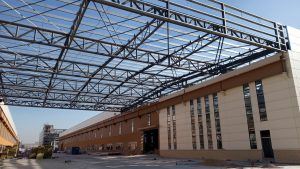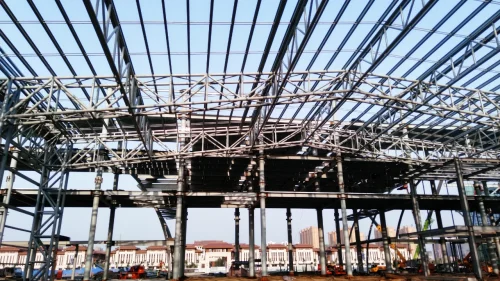Steel Truss Frame
Steel truss frame are structural systems composed of interconnected triangular units that efficiently distribute loads through axial forces (tension and compression) in their members. Below is a detailed analysis of their characteristics, applications, and design considerations:
Structural Composition & Mechanics
- Components:
- Top/Bottom Chords: Horizontal members resisting bending forces.
- Web Members: Diagonal/vertical braces transferring loads between chords, forming triangular units for stability.
- Load Distribution: Triangular configurations convert external loads (e.g., roof weight, wind) into axial forces, minimizing bending moments and optimizing material use.
- Materials: High-strength steel enables lightweight designs with spans exceeding 300 feet, reducing foundation costs.
Common Types & Applications
Steel trusses are categorized by geometry and use cases:
- Pratt Truss:
- Design: Diagonals slope downward toward the center; vertical members handle compression.
- Uses: Bridges, warehouses (e.g., Brooklyn Bridge).
- Warren Truss:
- Design: Equilateral triangles; diagonals alternate tension/compression.
- Uses: Long-span roofs (stadiums, aircraft hangars).
- Fink Truss:
- Design: W-shaped webbing; economical for medium spans.
- Uses: Residential/commercial roofs.
- Bowstring Truss:
- Design: Curved top chord; hybrid arch-truss for maximum span.
- Uses: Event venues (e.g., exhibition halls).
- Specialized Types: King/Queen Post (short spans), Howe (historic bridges), North-Light (industrial lighting optimization).
Advantages Over Alternatives
- Efficiency: 30–50% lighter than solid beams, reducing material and foundation costs.
- Versatility: Adaptable to curved, vaulted, or flat designs; prefabrication speeds installation.
- Durability: Resists rot, termites, and fire; recyclable for sustainable construction.
- Span Capability: Outperforms portal frames (>50m spans) and space frames in cost-effectiveness for roofs/bridges.
Applications in Construction
- Industrial: Warehouses, factories (clear-span layouts).
- Infrastructure: Bridges (e.g., Sydney Harbour Bridge), crane girders.
- Public Spaces: Stadiums, airports, theaters (column-free interiors).
- Residential: Attics, garages, and modern homes (Fink/King Post trusses).
Design Considerations & Challenges
- Load Analysis: Account for static (snow, dead loads) and dynamic (seismic, cranes) forces.
- Connection Complexity: Welded/bolted nodes require precision; maintenance in tall structures can be difficult.
- Corrosion & Insulation: Galvanization/protective coatings needed in humid areas; thermal bridging requires insulation.
- Cost Factors: Higher fabrication costs than portal frames but lower than space frames.
Future Trends
- Lightweight Optimization: High-strength steel alloys and AI-driven design (BIM/FEA) for material efficiency.
- Hybrid Systems: Integration with gridshells for architectural innovation (e.g., airport terminals).
- Sustainability: Recycled steel and modular fabrication align with green building standards (LEED).
Conclusion
Steel truss frames are indispensable for projects demanding long spans, structural efficiency, and design flexibility. While initial costs and connection complexity require careful planning, their longevity, adaptability, and sustainability make them optimal for modern industrial, commercial, and infrastructural applications. For projects prioritizing open spaces and resilience, steel trusses remain a superior choice over portal or space frames.



